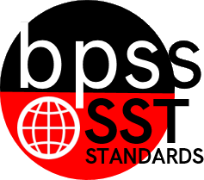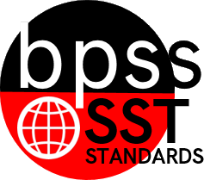3rd Grade Social Studies (Archived)
 BPS District Social Studies Standards Book
BPS District Social Studies Standards Book
SST-03 "I can ... statements"
1st Grade Social Studies
2nd Grade Social Studies
4th Grade Social Studies
5th Grade Social Studies
7th Grade Social Studies
8th Grade Social Studies
S |
|---|
SST-03.1.01
Student Learning Targets:Skills (Performance) Targets
Proficiency Rubric
ResourcesWebsites Helping Your Child With Social Studies
Vocabulary
| ||||||||||||||||||||||||||||||||||||||||
SST-03.1.02
SST-03.1.02 Create a mental map that demonstrates understanding of the relative location, direction, size and shape of the local community (e.g., school, hospital, post office, stores, landmarks, home).Student Learning Targets:Knowledge Targets
Reasoning Targets
Skills (Performance) Targets
Product Targets
Proficiency ScaleThe Student ...(1) Beginning
(2) Developing
(3) Proficient
(4) Advanced
Resources | |
SST-03.1.03
Student Learning Targets:Skills (Performance) Targets
Proficiency Rubric
ResourcesWebsites Helping Your Child With Social Studies
Vocabulary
| ||||||||||||||||||||||||||||||||||||||||
SST-03.1.04
Student Learning Targets:Knowledge Targets
Proficiency Rubric
ResourcesWebsites Helping Your Child With Social Studies
Vocabulary
| ||||||||||||||||||||||||||||||||||||||||
SST-03.1.05
SST-03.1.05 Construct time lines (i.e. periods in their own lives and the lives of their family members).Student Learning Targets:Knowledge Targets
Reasoning Targets
Skills (Performance) Targets
Product Targets
Proficiency ScaleThe Student ...(1) Beginning
(2) Developing
(3) Proficient
(4) Advanced
Resources | |
SST-03.1.06
SST-03.1.06 Interpret simple time lines (e.g., identify the time at which events occurred, the sequence in which events developed, and what else was occurring at the time).Student Learning Targets:Knowledge Targets
Reasoning Targets
Skills (Performance) Targets
Product Targets
Proficiency ScaleThe Student ...(1) Beginningis only able to answer basic questions about a timeline such as
(2) Developingis able to answer questions about a timeline by answer the following questions.
(3) Proficientis able to explain the meaning or interpret the information from the timeline by answering the following questions.
(4) Advanced
ResourcesVocabulary
| |
SST-03.1.07
SST-03.1.07 Use spatial terms to describe the world (i.e., equator, hemispheres).Student Learning Targets:Knowledge Targets
Reasoning Targets
Skills (Performance) Targets
Product Targets
Proficiency ScaleThe Student ...(1) Beginning
(2) Developing
(3) Proficient
(4) Advanced
Resources | |
SST-03.2
Narrative for the Important Historical EventsThrough active learning experiences, third grade students gain knowledge and process information about their local community from a variety of resources. Students describe how significant people, events and developments have shaped their own community and region; compare their community to other communities in the region in other times and places; and use a variety of resources to gather information about the past. Calculation Method for StandardsStandards are larger groups of related benchmarks. The Standard Grade is a calculation of all the related benchmarks. Click on the benchmark name below each Standard to access the learning targets and proficiency rubrics for each standard's related benchmarks. | |
SST-03.2.01
SST-03.2.01 Explain the importance of the accomplishments of scientists and inventors (e.g., light bulb, automobile, discovery of electricity, computer, telephone).Student Learning Targets:Knowledge Targets
Reasoning Targets
Skills (Performance) Targets
Product Targets
Proficiency ScaleThe Student ...(1) Beginning
(2) Developing
(3) Proficient
(4) Advanced
Resources | |


 Standard 1:
Standard 1: